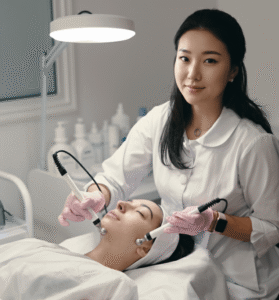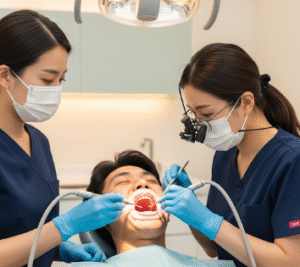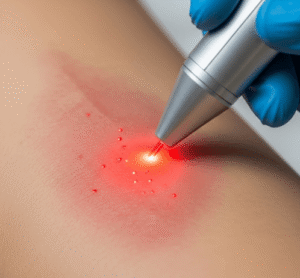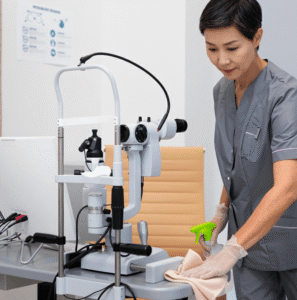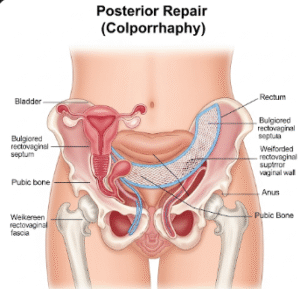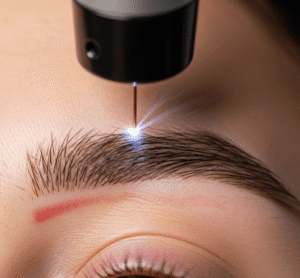What is an Echocardiogram?
An echocardiogram is a non-invasive imaging test that uses ultrasound waves to create detailed images of the heart. It evaluates the structure, function, and blood flow of the heart, allowing physicians to diagnose a wide range of cardiac conditions.
There are several types of echocardiograms:
✔️ Transthoracic Echocardiogram (TTE) – Standard, performed via the chest wall
🔹 Transesophageal Echocardiogram (TEE) – Ultrasound probe inserted into the esophagus for clearer images
🔸 Stress Echocardiogram – Evaluates heart function under exercise or pharmacological stress
🔹 Doppler Echocardiography – Assesses blood flow and valve function
🔸 3D Echocardiography – Provides three-dimensional imaging for advanced evaluation
In Korea, echocardiography is widely performed in hospitals, specialized heart clinics, and diagnostic centers. The country is known for advanced cardiac imaging technologies, AI-assisted interpretation, and highly trained cardiologists, making it a top destination for both local and international patients.
➡️ Visualizes heart structure and function in real-time
➡️ Detects heart valve disorders, congenital defects, and cardiomyopathy
➡️ Monitors treatment outcomes and heart health
Why It’s Done
Echocardiograms are performed to diagnose, monitor, and manage heart conditions.
✔️ Evaluate heart function – Measure ejection fraction and chamber sizes
✔️ Detect structural abnormalities – Heart valve disease, congenital defects, septal defects
✔️ Investigate symptoms – Shortness of breath, chest pain, palpitations, or fainting
✔️ Monitor chronic heart disease – Heart failure, cardiomyopathy, or post-heart attack recovery
✔️ Guide surgical or interventional procedures – Valve repair, congenital defect closure, or device placement
Benefits:
➡️ Non-invasive and safe – No radiation exposure
➡️ Real-time imaging – Provides dynamic information about heart movement
➡️ Early detection – Identifies cardiac issues before symptoms worsen
➡️ Treatment planning – Supports personalized therapy decisions
In Korea, echocardiography is part of routine heart health check-ups and is often recommended for high-risk individuals, including those with diabetes, hypertension, or a family history of heart disease.
Alternatives
While echocardiography is highly effective, alternative methods include:
⭐ Electrocardiogram (ECG) – Detects electrical activity but provides no structural detail
⭐ Cardiac MRI – Detailed imaging, especially for tissue characterization, but more expensive and time-consuming
⭐ Cardiac CT Scan – Provides high-resolution images of coronary arteries and cardiac structures
⭐ Nuclear Stress Test – Evaluates blood flow to the heart during stress, useful for ischemic heart disease
👉 Echocardiography remains the first-line, non-invasive, cost-effective option for evaluating heart structure and function.
Preparation
Preparation for an echocardiogram is generally straightforward, with minor variations depending on the type:
🔹 Transthoracic Echocardiogram (TTE) – No special preparation required; patients may wear loose clothing
🔹 Transesophageal Echocardiogram (TEE) – Fasting for 4–6 hours recommended; sedatives may be administered
🔹 Stress Echocardiogram – Avoid caffeine, smoking, and certain medications; comfortable clothing required
⭐ Patients should bring a list of medications and medical history
⭐ Notify the cardiologist of pregnancy or any allergies
How It’s Done
The procedure varies slightly by type but follows a structured and patient-friendly approach:
- Transthoracic Echocardiogram (TTE)
✔️ Patient lies on a padded table
✔️ Ultrasound gel applied to the chest
✔️ A transducer is moved across the chest to capture images
✔️ Takes 20–40 minutes - Transesophageal Echocardiogram (TEE)
🔹 Sedation administered
🔹 Probe inserted into the esophagus to obtain clear images
🔹 Procedure takes 20–60 minutes
🔹 Provides detailed evaluation of valves, atria, and septum - Stress Echocardiogram
➡️ Heart is stressed either via exercise or medication
➡️ Images captured before, during, and after stress
➡️ Assesses blood flow and wall motion abnormalities - Doppler & 3D Imaging
🔸 Measures blood flow velocity and pressure gradients
🔸 3D imaging provides comprehensive views for surgical planning
Highlights:
✔️ Non-invasive (except TEE)
✔️ Real-time imaging of heart chambers, valves, and blood flow
✔️ Safe for repeated follow-ups
Recovery
Recovery from an echocardiogram is generally immediate:
✔️ No downtime after TTE or Doppler
✔️ Mild throat soreness may occur after TEE, resolving in a few hours
✔️ Resume normal activities immediately
✔️ Follow-up appointments may be scheduled depending on results
⭐ Stress echocardiography may require short-term rest after testing
⭐ Patients are advised to drink water and eat normally post-procedure
Complications
Echocardiography is very safe, with minimal risk:
⚠️ Mild discomfort – Pressure from the transducer
⚠️ Sore throat or gagging – With TEE, usually temporary
⚠️ Reaction to sedatives – Rare, mild sedation-related side effects
⚠️ Arrhythmias during stress echocardiogram – Monitored and managed immediately
➡️ In Korea, advanced monitoring and experienced staff ensure rare complications are handled promptly.
Treatment Options in Korea
If abnormalities are detected, Korea provides comprehensive cardiac treatment:
🏥 Medical Therapy – Beta-blockers, ACE inhibitors, anticoagulants, or antiarrhythmic medications
🏥 Interventional Cardiology – Angioplasty, stent placement, or valve repair/replacement
🏥 Cardiac Surgery – Open-heart surgery for complex defects or valve replacement
🏥 Lifestyle & Rehabilitation Programs – Diet, exercise, and cardiac rehabilitation
🏥 Follow-up Echocardiography – Regular monitoring for chronic heart conditions
Why Korea is a preferred destination:
✔️ State-of-the-art imaging technology – 3D echocardiography, AI-assisted diagnostics
✔️ Expert cardiologists and cardiac surgeons – Internationally trained and experienced
✔️ Affordable costs – Lower than Western countries without compromising quality
✔️ Medical tourism support – Translation services, travel assistance, and coordinated care packages
Approximate Costs in Korea:
🔹 Transthoracic Echocardiogram (TTE) → $80 – $150
🔹 Transesophageal Echocardiogram (TEE) → $200 – $350
🔹 Stress Echocardiogram → $150 – $300
🔹 3D Echocardiography → $250 – $500
Conclusion
An echocardiogram is a vital diagnostic tool for evaluating heart function and structure. It helps:
✔️ Detect heart disease early
✔️ Monitor treatment outcomes
✔️ Guide interventional and surgical decisions
✔️ Improve long-term cardiac health
In Korea, patients benefit from:
✔️ Advanced imaging technology
✔️ Highly skilled cardiologists
✔️ Affordable and accessible diagnostics
✔️ Comprehensive cardiac care and follow-up
👉 Whether for routine screening, diagnosis of symptoms, or monitoring chronic heart conditions, echocardiography in Korea ensures accurate, safe, and effective cardiac evaluation.
Key Message: Echocardiography provides critical insight into heart health, enabling timely interventions and improved quality of life.


